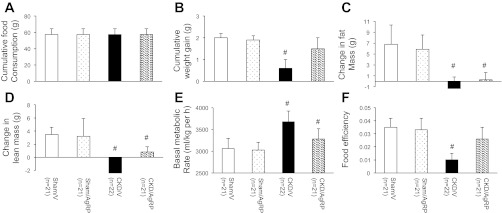Fig. 2.
Chronic kidney disease (CKD) and sham mice were administered with agouti-related peptide (AgRP) or vehicle for 14 days. At the end of study, cumulative food consumption (A) and cumulative weight gain (B) were recorded. Live mice were scanned by DXA to determine the change in fat mass and lean mass. Mice were scanned 1 day before the starting of the experiment, followed 14 days later by a second DXA scan. Final results of change in fat (C) and lean mass (D) relative to baseline are shown. Basal metabolic rate (E) and food efficiency (F) were measured in experimental animals at the end of the study. Basal metabolic rate (ml·kg−1·h−1) is calculated as the average three lowest readings obtained during the recording period. Food efficiency was calculated by dividing the total weight gained (in grams) by the total amount of food consumed (in grams) over the 14-day treatment period. Four groups of mice were included: Sham/V, Sham/AgRP, CKD/V, and CKD/AgRP. Sham/AgRP, CKD/V, and CKD/AgRP mice were compared with Sham/V mice. Data are means ± SE. #P < 0.001.

